
table of contents
- Effective ways to remove clover
- Mow properly
- Eliminate deficiency symptoms
- Scarifying
- Cutting out
- Cover
- Hot water
- The chemical club
- Salt or Vinegar - Home Remedy or Problem?
Clover is considered a nutritious and easy-to-grow forage crop. At home race we don't want him on the other hand. Because it is able to completely displace the lawn piece by piece. With our help, however, you can effectively remove it.
Effective ways to remove clover
There are numerous different ways to displace the annoying clover from your own lawn. Which of these is most suitable depends on how far the plant has already spread and which species of this family of species is actually present. Because even with clover, there can be blatant differences from species to species.
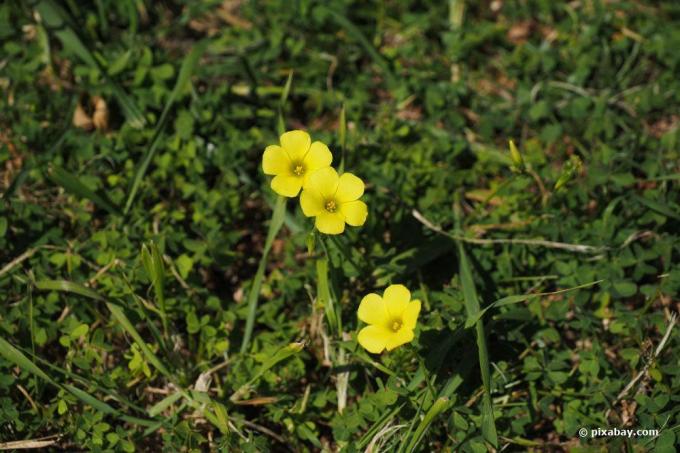
Mow properly
Before performing any actual clover removal measures, you should know the basics of lawn care, So that the annoying visitor cannot spread out and displace the lawn in the first place: the right one Mowing. The right cutting height is essential here. This is around five to six centimeters. If you keep shortening the lawn, the clover can develop faster than your lawn will. Once lawn plants are covered by the clover, they don't have much to offer against it. The longer the lawn is left, the sooner the blades of grass protrude over the clover and thus still get enough light and water. Your lawn is generally more resistant to the different
Clover species.Eliminate deficiency symptoms
One reason why clover can spread rapidly and even displace lawn completely is the fact that it can cope better with poorly supplied soil than the actual lawn. So he is able to act from a better starting position and take up the fight for the growth area. Depending on the type of clover, an increased occurrence or even a clearly detectable spread indicates different symptoms of deficiency. Fight the deficiency, set the course to effectively displace the clover:
Horn clover

Spread at:
- nitrogen-poor soils due to symbiosis with nitrogen-fixing bacteria (own "fertilizer production")
Tip: Use horn meal in particular instead of other nitrogen fertilizers. It contains a lot of nitrogen without the phosphate that is usually associated with it. This is how you strengthen the lawn without doing something good for the clover at the same time.
Remedy:
- Use of nitrogenous fertilizers
- Feeding organic, nitrogenous soil, e.g. B: Mulch, compost, manure
Wood sorrel

Spread at:
- lime-poor, acidic soil
Remedy:
- Increase the pH value of the soil using lime, basalt flour or similar
White clover
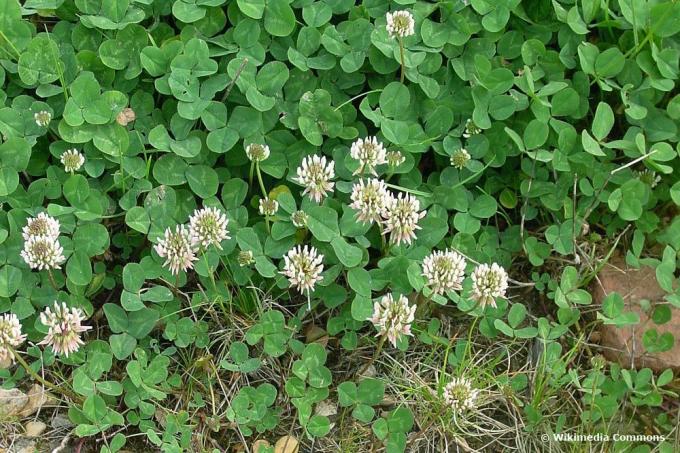
Spread at:
- calcareous soil
- nutrient-poor subsoil
Remedy:
- Add soil lime
- Supply nutrients through organic or mineral fertilizers
- Take measures to improve the soil (work in compost, manure or humus, check the pH value and, if necessary, regulate)
Attention: The removal of poor soil quality can create a basis on which the clover plants are no longer able to displace the lawn. An already existing spread can hardly be removed with it. Because even with "equivalent" growing conditions, the clover is often superior to the lawn. With its large leaves, it can tap light and rain and still gain further advantages. The soil improvement can therefore only be carried out as an accompanying or even preventive measure, while the removal must be carried out by other measures described below.
Scarifying
The white clover is considered to be particularly easy to control. You can usually help it with scarifying, which is an important measure when preparing the lawn in the spring. In this way you can give the lawn an optimal start and keep the white clover small from the start. With these prerequisites, it is hardly able to displace the lawn plants over a large area.
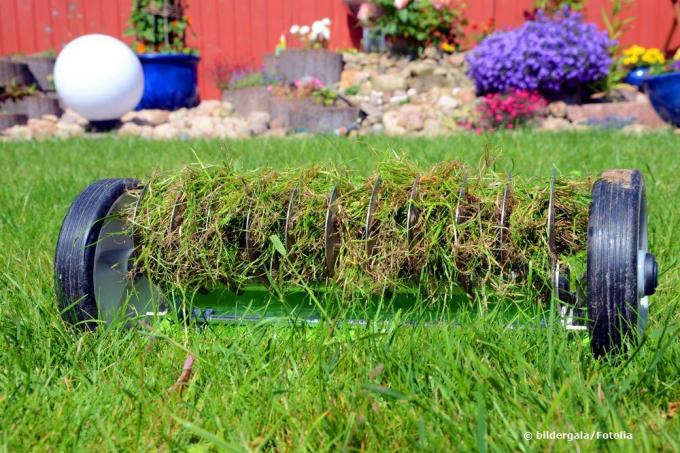
Mode of action:
- better ventilation of the roots of the lawn through cuts in the ground
- Removal of dead lawn substance for better air and water supply
- Reduction of additional pollution from decomposition bacteria in dead lawn mass
- Weakening of the clover by cutting up the flatly spread roots
Complementary measures:
- Supplementary fertilization for optimal lawn recovery
- intensive watering for rapid recovery of the lawn plants
Cutting out
Horn clover in particular can be removed by scarifying, mowing, etc. hard to get a grip on. The wildly sprawling and at the same time very robust plants displace grass, drag and drop, until ultimately large areas of clover remain without any lawn growth. The only effective lawn-friendly variant is therefore to cut out each individual clover plant.
Proceed:
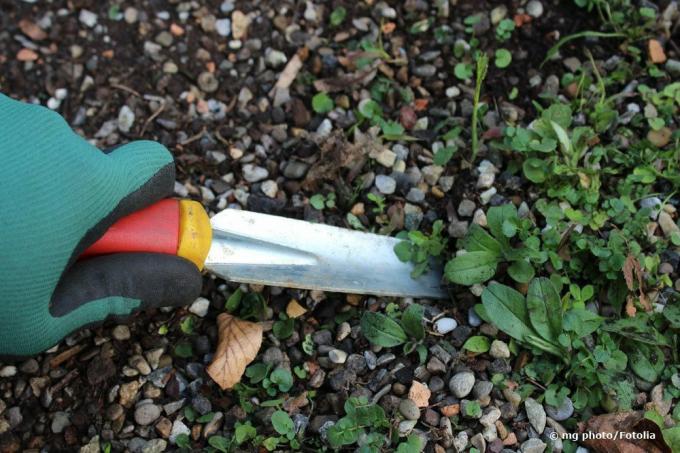
- Identify the clover plant
- Follow side shoots to the roots
- Cut out the root completely vertically with a weed cutter, spatula or other tool
- Dispose of the clover plant in the residual waste (due to further spread in composting)
Note: Be careful not to cut too close to the clover so that you grasp the whole root. On the other hand, if you prick off too generously, a clearly visible gap will remain in the lawn, which you will then have to fill by reseeding.
Cover
Despite its resilience, clover is also dependent on water and sunlight. You can therefore treat heavily infested areas by covering them with a waterproof and lightproof film. The clover plants die due to the lack of vital media, while the lawn recovers much faster despite the weakening. Used correctly, this measure will even enable your lawn to outstrip the clover itself.
Proceed:
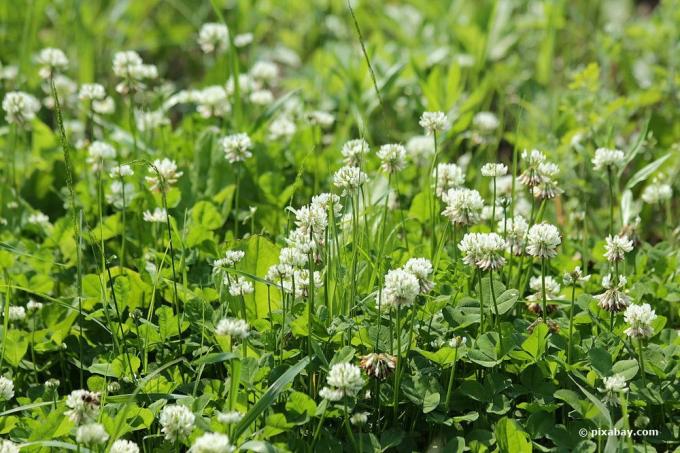
- Mow heavily infested lawns briefly to remove clover reserves in the leaves
- Cover the surface with light and waterproof film, e.g. B. colored garden tarpaulin
- Remain for around 2 to 3 weeks, check the condition of the clover regularly
- Remove cover from brown, dried-up clover
- Enable weakened lawns to regenerate optimally through the use of water and fertilizers
Hot water
One reads again and again about keeping clover in check with hot water. In fact, the proteins in the plant cells degenerate from around 60 degrees Celsius. If water above this temperature is poured on the clover, the plants perish and dry out. They can then be easily removed by hand. It is important that only clover is watered, as this will also kill the lawn.
Attention: Hot water is more effective the hotter it is. Be very careful not to water yourself. Otherwise there is a risk of scalding or serious injuries that have to be treated in the hospital!
The chemical club
Finally, of course, there is still the option of using chemicals to destroy the clover. Because of the general burden on plants and animals, chemical weed killers should only be used if other measures are not effective or cannot be implemented. Weed killers that are “dicotyledonous” are particularly suitable. These include the various types of clover, but also other undesirable plants such as the dandelion. You can also drive him out permanently and safely.
Salt or Vinegar - Home Remedy or Problem?
Various advisors point out salt and vinegar as effective home remedies for the clover. In fact, both substances work against the growth. However, you do not only remove clover, but also combat all other plants and animals in the area worked in this way. In addition, you change the soil characteristics sustainably, so that sustainable growth will hardly be possible afterwards. Therefore, both agents are now prohibited by the Plant Protection Act and may no longer be used.
